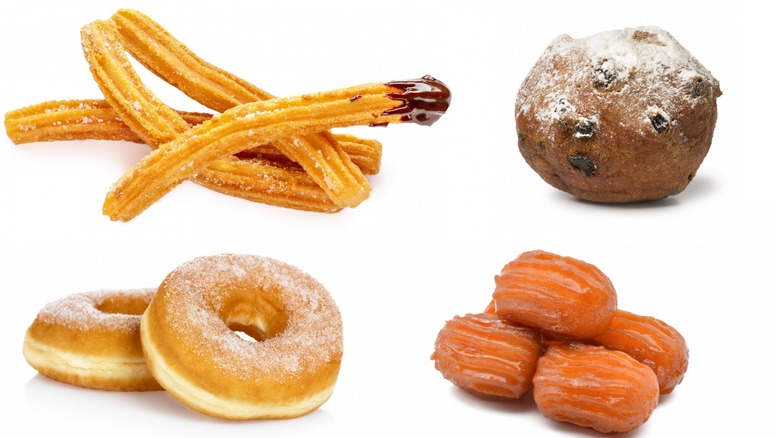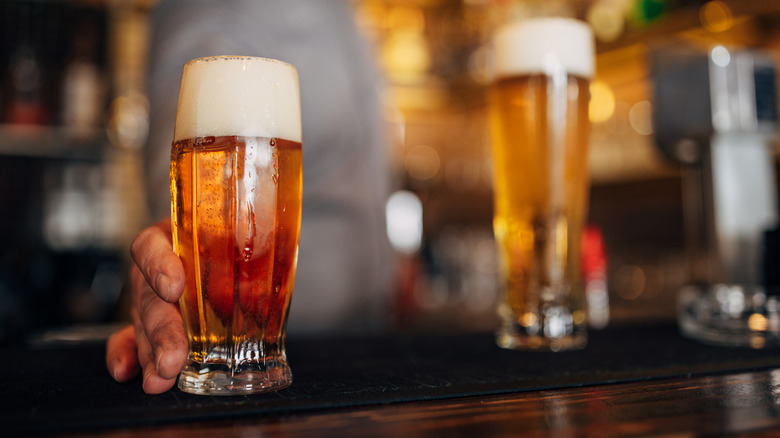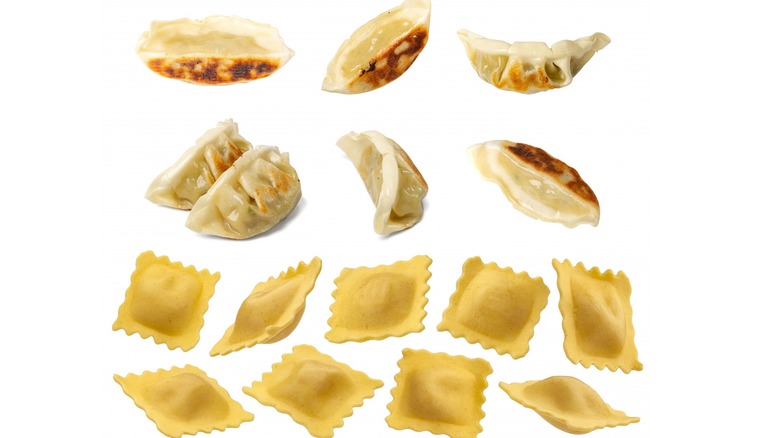Doppelgänger Foods: What They Are And How We Get Them
In German folklore, a doppelgänger was a dreaded thing. It was said that every living creature had a duplicate self in the form of a ghostly spirit and that meeting one's doppelgänger (German for "double-goer") was a sign of impending death. Today, we regularly seek and celebrate doppelgängers wherever we can. Perhaps you've been told you have a celebrity doppelgänger. Depending on your perception of that individual, it may have given you an ego boost. Foods can have doppelgängers, too. In fact, many foods have multiple doppelgängers all over the world.
Doppelgänger foods are dishes that evolved in separate cultures and places yet bear a striking resemblance to one another. Consider, for example, the doughnut. Nearly every culture enjoys some form of sweet fried dough. Spanish churros and French beignets have achieved great popularity in the United States. Equally worthy of note are Dutch oliebollen, spherical donuts filled with dried fruits, Chinese youtiao, doused in sweetened condensed milk, and Turkish tulumba tatlisi, which look like truncated churros, coated in syrup and served cold.
From country to country and continent to continent, we see the same culinary concepts repeated. It's natural to assume this comes from cross-cultural contact; one people introducing a dish to another people, who then reimagine it with their own local ingredients. Many of these replicate foods were invented before the cultures in question ever made contact with each other, though. Why then, are there so many doppelgänger foods?
The theory of multiple discovery
It would be impossible to trace the history of every doppelgänger dish but one potential explanation for these many recurrences lies in the theory of multiple discovery, or simultaneous invention. As described by Quartz, multiple discovery is "the phenomenon of two people inventing or discovering the same thing in two different locations without any contact". Examples of multiple discovery include Charles Darwin and Alfred Russel Wallace both forming the theory of natural selection in the 1800s and Jonas Salk and Albert Bruce Sabin both inventing polio vaccines in the 1950s. Essentially, the theory of multiple discovery boils down to that saying, "great minds think alike".
Certain discoveries, it seems, are inevitable and this applies to food and drink as well. A perfect example of multiple discovery at play in the culinary world is the invention of beer, which appears to have occurred in most ancient civilizations. In an interview with Wine Enthusiast, anthropologist Patrick McGovern attributes the simultaneous invention of brewing by multiple cultures to the fact that "beer tends to be the most common beverage you can produce from any carbohydrate." Carbohydrates are present in most foods, forming a significant portion of our diets throughout history. It is no surprise then that people all around the world would stumble across some of the same carbohydrate-based creations, beer being chief among them. Similar occurrences can be found throughout global cuisine.
Examples of doppelgänger foods
One of the most striking instances of doppelgänger food is the uncanny similarity between Australian lamingtons, Croatian čupavci, and South African ystervarkies. All three of them are nearly identical; little cubes of yellow sponge cake, covered in chocolate sauce and coconut flakes. Yet, they emerged on completely different continents. Another cross-continental instance of twin foods is the case of Mexican tamales and Chinese zongzi. Tamales contain various fillings surrounded by masa dough and steamed in either corn husks or banana leaves. They've been around since the Mayan era. Zongzi are very similar, except that the masa is swapped for sticky rice. They too are typically steamed in banana leaves and have been part of Chinese cuisine since at least 276 B.C.
There may be no more pervasive example of doppelgänger foods than dumplings. Like doughnuts, nearly every culture in human history has eaten some form of dumpling. In East Asia, there is a clear similarity between Chinese dumplings, Japanese gyoza, Korean mandu, and Nepalese momo. Some of these may have been invented in response to cultural exchange between these countries but that wouldn't explain the subtle differences between dumplings and Polish pierogi. The same goes for Russian pelmeni and Latin American empanadas. Even Italy's famous ravioli and tortellini can be considered forms of dumplings. Little dough packages, it seems, hold some intrinsic appeal to us. They are evidence that, all around the world, great mouths eat alike.


